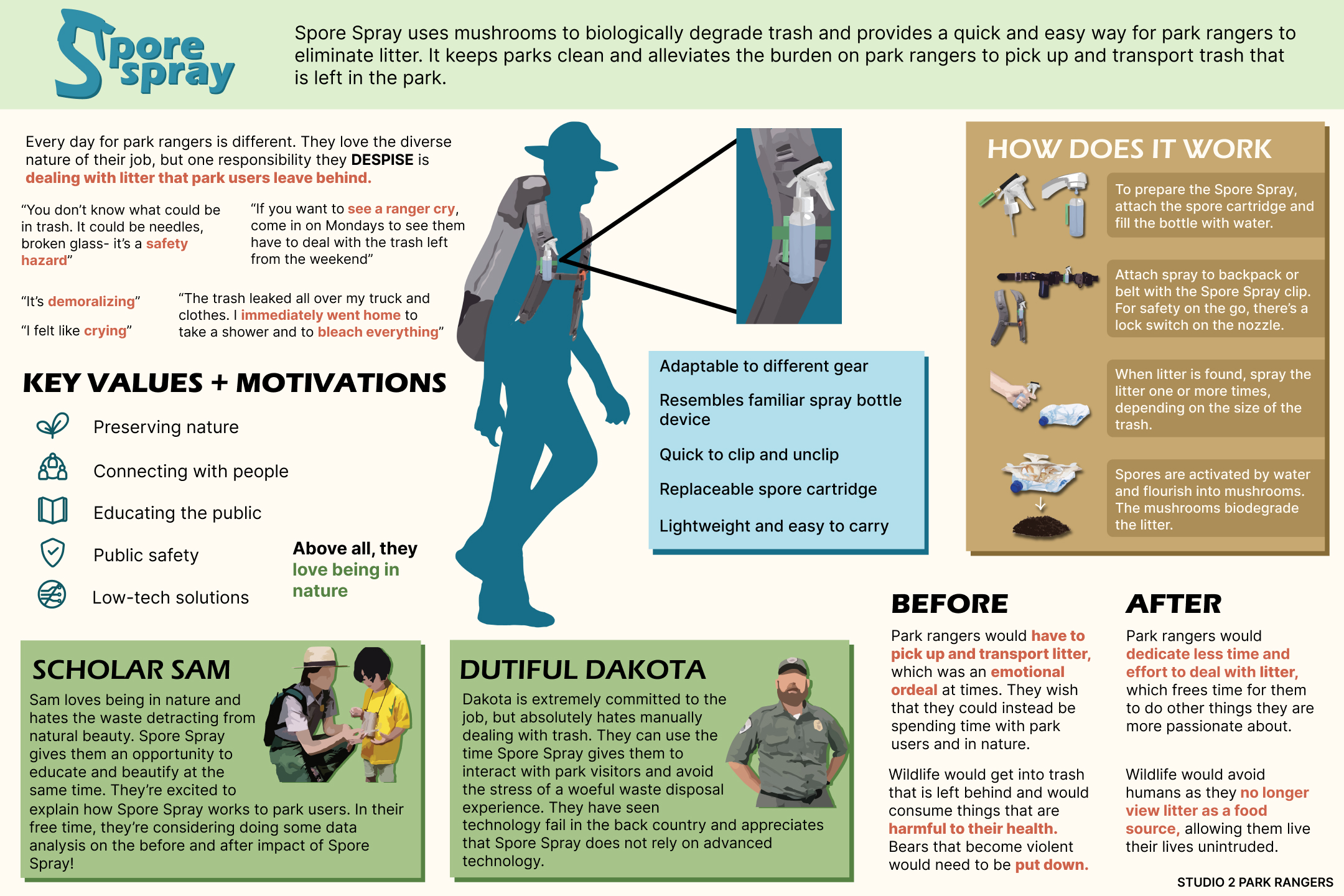Explore
Initial engagements with stakeholders
In this first phase, we reached out to and interviewed 10 different park maintenance workers and park rangers. We split into teams of 2 and conducted engagements over Zoom, went to parks in-person, and over the phone. After each engagement, we debriefed with the entire team and created a people portrait for each park worker we met with. To protect the privacy of our stakeholders, all names and locations are pseudonymized.
For each engagement, we wrote down customer goals, some meaningful and memorable quotes, some challenges they faced, what they did in their daily life, and some gear and tools they used. These customer portraits were used to debrief each engagement and make sure all team members were aware of information collected during the engagement.
Creating frameworks
Once we had debriefed all of the workers we had engaged with, we created frameworks to help generalize information for our stakeholder group as a whole. We plotted our customers on an OCEAN attribute spectrum and several 2x2 Matrices to identify similarities in personality traits and motivations. These frameworks were helpful in creating our 3 customer personas that represent our stakeholder group: Scholar Sam, Dutiful Dakota, and Pioneer Peyton.

The 2x2 matrices had the following axis labels:
- Seeking good or avoiding bad vs serve public directly or seve organization
- Ego syntonic (consistent with one's self image) or ego dystonic (conflicts with ones self image) vs reactive or proactive work
- High or low openness to experience vs same daily routine or everyday is different
We then created 3 personas to represent the park rangers we engaged with:
- Scholar Sam
- Just received their PHD in environmental studies. Seeks to make information accessible and to educate others.
- Introverted, frustrated with the lack of caring from some park users, wants to educate over punish and penalize.
- Wants to continue their studies and gain information about the land and also do the things they enjoy doing.
- Monitors the land and collects data for organization.
- Dutiful Dakota
- In their late 30's with prior experience in management and business.
- Parts of their job are definitely mundane- but they get through it each day knowing that they're part of a bigger mission.
- Wants to serve the greater good and finish the job right. Is a follower and fits in the system.
- Facilities, maintenance, reporting, is almost always on-call.
- Pioneer Peyton
- Has been working as a ranger for a few year, but just early accepted a management position so they can do more to act.
- Wants to improve others' quality of life and institute direct change.
- Risk taking, embraces change, will go above and beyond at their own self-expense.
- Works as authority, outreach, and carries lots of responsibility.
CONCEPTUALIZE
Ideation
In this phase, we started by identifying areas of opportunity that we could explore for our design solutions. These areas were pulled directly from themes of challenges our customers face in their daily work that we identified in our findings during the previous phase. My team then challenged ourselves to generate 100 broad ideas that we plotted using the Fanciful Horizon method to easily see what ideas are bold to push our thinking in lateral and impactful ways. We then created gallery sketches for several ideas that we wanted to test with our customer group.
Co-design
We conducted 5 different co-design sessions with our stakeholders. The goals of these meetings were to receive feedback on preliminary ideas that we ideated as a team and to provide opportunities for our stakeholders to be part of the design process. The methods that we used were Card Sorting and Props to gain a deeper understanding on values that our stakeholders have and to allow them to try out and engage with some of our design ideas. Our co-designs took place in person or over Zoom and on Miro.
We debriefed our co-design sessions as a team and incorporated the feedback to continue refining and generating idea. By the end of the phase, we had 9 bold ideas represented as a gallery sketch that was build upon our personas, values, areas of opportunity, and co-design sessions. These 9 ideas are categorized into 3 broader convergent directions: Documentation and accessibility of information, Park User Safety, and Waste Management.
.jpg)
